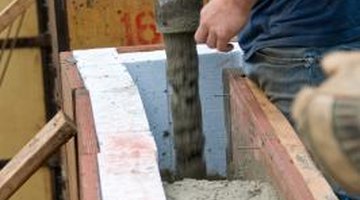What Is the Width of an Average Wall?
Wall width or thickness affects a building’s insulation. Interior and exterior walls are typically built with vertical 2-by-4 or 2-by-6 studs, according to nationally syndicated author and home improvement expert Don Vanderport. Determining the appropriate wall thickness for your interior and exterior walls depends on factors like outside climate and indoor room temperatures.
Average Dimensions

The composition of interior and exterior 2-by-4 and 2-by-6 walls comprises metal studs as well as base and top plates. Although metal studs are labeled as 2-by-4, their measurements are approximately 3 ½ inches deep and 1 ¾ inches wide. Likewise, 2-by-6 metal studs measure approximately 5 ½ inches deep and 1 ¾ inches wide. The depth of metal studs also indicates the amount of space available for wall insulation, such as fiberglass batts.
Considerations
Using 2-by-6-inch rather than 2-by-4-inch studs not only gives you more room for insulation, but also cut lumber costs. For example, homes that lose significant heat over a short period of time require the added insulation provided by 2-by-6 walls. These includes residences located in extreme climates or near sea level. Moreover, 2-by-6 studs can be installed 24-inches apart. In comparison, 2-by-4 studs are typically spaced 16 inches apart in walls. Thicker walls also improve R-value, which is the home's ability to reduce heat transfer through walls.
Cost
Nationally syndicated newspaper columnist Tim Carter advises homeowners to weigh the initial cost of installing thicker walls versus energy fuel savings in the long-run. Purchasing and installing wall studs, top and bottom plate faces, insulation materials and both window and door extension jambs can prolong the amount time it takes to receive a return on your investment. As of November 2011, Carter estimates that upgrading from 2-by-4 to 2-by-6 exterior walls in a single, story ranch house would run approximately $1,020. Higher square footage requires a greater investment when upgrading wall width.
Expert Insight
The type of material used in walls is just as important as width and thickness for lowering energy bills during the summer and winter months. The Portland Cement Association estimates that heating and cooling comprise anywhere from 20 to 72 percent of homes’ annual energy costs. Studies showed that homes with concrete walls and optimal insulation performed better than frame walls due to concrete’s thermal mass. Moreover, concrete walls’ ability to slowly absorb and store heat during the day reduces heat transfer and energy needs. The thickness of insulation--and thus the width of walls--also impact home energy use.
References
Writer Bio
Bridgette is an aspiring yogini, newbie coder and seasoned marketing writer in the higher ed space. She's written hundreds of articles on a wide range of topics including, entrepreneurship, K-12 pedagogy and information technology. Bridgette's work has appeared on Connect: IT at NYU, Noodle Pros, QuickBooks Small Business Center, Trails.com and USA Today.
Photo Credits
- Jupiterimages/Photos.com/Getty Images
More Articles


